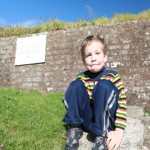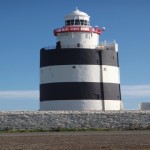Tom turned 5, appropriately enough, five hours earlier than he might have had he been in Canada! In spite of his congestion and continued raspiness he remains in good spirits and ever the trooper as we continued to explore southern Ireland. We’re in a small community just south of Waterford (the crystal place) that is in the country (sheep, cows) but dotted with estates. And by estates, I mean country estates that remind you of English (or Irish, but most of us will think “English”) gentlemen squires roaming the grounds wearing their wellingtons, their melon hats and smoking a pipe. I’m trying to think of a way I can become a country squire… unsuccessfully, thus far, since most of my plans have been predicated on Erin accepting a fantastic job offer in Ireland. So not happening…
Our first adventure was getting to the ferry…I’m still amazed at the narrow roads that represent important thoroughfares. Seriously. Our road standards are minimum of 22 feet or 7.5 m plus a 1m shoulder on each side. Here we’re looking at (I’m estimating) 18 feet of roadway and, in most case, a shoulder wide enough to paint a yellow line on. And in many case, you are tunneling through vegetation…I’ll have to get a pic of that.
Anyways, made it down the cliffside to the ferry port, hop to the other side and promptly got lost trying to find Duncannon Fort. We lost the cell signal halfway there so we had no mapping capability…relying on visual reconnaissance using local semaphores (ie. signs) was not particularly reliable. Eventually, we found it, drove through the gates and suddenly found ourselves wondering what the motor etiquette was when faced with a moat? Should one traverse the moat first or ask permission?

At this time of year, there are few tourists at Duncannon, so we had the run of the fort. This fort dates back to the Norman fortifications during Strongbow’s time and has been used as a defensive position throughout the ages (from the Norman conquest of the vikings to the Allies defense against German U-Boats). Needless to say, it’s been renovated a number of times.
Some of the places we visited at the fort were a bit on the rough side, presentation-wise. I’m guessing there are so many historically significant sites in this country that there isn’t enough money to preserve them all. But really…you use some of these at your own risk, at least compared to the “safety imperatives” I’m accustomed to in Canada. And perhaps that’s not a bad thing… put the responsibility of minding your children in the parents’ hands instead of in the site operator’s hands.
Take this spot, for example:
 The sign reads “Do not walk on this wall. Sheer drop.” And indeed it is. A stone wall with a 40 foot drop onto hard rocks. In Canada, there would be a 10 foot high fence, security guards, a liability waiver and a guide. Here…just a sign that says “please don’t be stupid.” There’s something to be said about that…unless you’re a lawyer.
The sign reads “Do not walk on this wall. Sheer drop.” And indeed it is. A stone wall with a 40 foot drop onto hard rocks. In Canada, there would be a 10 foot high fence, security guards, a liability waiver and a guide. Here…just a sign that says “please don’t be stupid.” There’s something to be said about that…unless you’re a lawyer.
After that it was off to one of the southernmost tips of the Waterford county coastline. At Hook Point, in the 13th Century, there was a monastic order that grew tired of seeing ships get torn up by the reefs so they built a tower and lit a fire on it to warn ships of the approaching danger. The tower included sleeping quarters for the monks, a kitchen and some other necessities. Sometime later, the tower was added to (above the black and white bands) in order to put in a rotating beacon and space for a light keeper, his assistant and their families.

The whole thing is automated and computerized now but walking up those 115 steps and seeing the thickness of the walls, the fireplaces, the little chapel on the third level and the dugout they called the “loo”, makes me think we, of this century, would not cope well with the conditions of previous centuries. NB: there was a light keeper up until 1996 here!
 People raised families on these rocks… it was windy enough today that I considered lashing down my children so they wouldn’t get blown away! There were signs warning against “rogue waves”. Just sayin…
People raised families on these rocks… it was windy enough today that I considered lashing down my children so they wouldn’t get blown away! There were signs warning against “rogue waves”. Just sayin…
 Anyways… on the way back I had to stop in to take a few pix at the site of the old Hook church where the monks were based. Pretty awesome…and some of the tombstones were pretty recent, meaning that the attachment of this community to its roots runs very deep. Personally, I think a trip to Europe (almost anyplace in Europe) should be mandatory for anyone of school age in North America. How else can you understand history unless you get some taste of it on the other side of the Atlantic?
Anyways… on the way back I had to stop in to take a few pix at the site of the old Hook church where the monks were based. Pretty awesome…and some of the tombstones were pretty recent, meaning that the attachment of this community to its roots runs very deep. Personally, I think a trip to Europe (almost anyplace in Europe) should be mandatory for anyone of school age in North America. How else can you understand history unless you get some taste of it on the other side of the Atlantic?
BTW… the “Hook” I’m referring to relates to the local geography. There is this hook-shaped peninsula here and, further down, there is a crook in the river. According to local legend, many years ago, Cromwell is quoted to have said “By Hook or by Crook”, he would control this waterway. Apparently, he was wrong… but the rest is history.